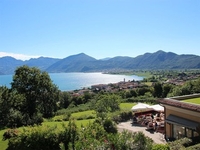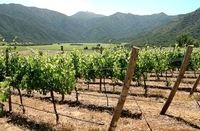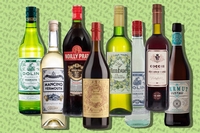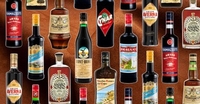Selecting the appropriate beverage to enjoy for starters can enhance the mood of any occasion. The dictionary defines apéritif as, "A drink of alcoholic liquor or wine taken to stimulate the appetite before a meal." The word itself stems from the Latin
aperire, meaning "to open." A good apéritif is a beverage that does just that – opens the way to a meal, party or other event. Many wines and wine-based beverages are excellent apéritifs and in this brief account we will discuss the characteristics of several possibilities.
Let's begin with a classic wine aperitif, namely, Champagne. Although the term Champagne has been used (or, some would say, abused) throughout the world to describe nearly any wine with fizz, to the purist, Champagne comes only from the area known as La Champagne in northern France. Bubbly wines from other regions are sparkling wines. Whatever its provenance, a well-made bubbly can be a stellar apéritif. The combination of zesty, penetrating aromas and racy, invigorating flavors activates the salivary glands, literally gets your mouth watering. This is the purpose of an apéritif – to prepare the palate to fully enjoy the flavors of whatever food is to follow. The chalky soils and cool climate of La Champagne, along with a winemaking tradition developed over centuries, imbues true Champagnes with a fascinating breadth and length of flavor.
There are fine sparkling wines made throughout the world, with good products available from Australia, Argentina, the U.S. and throughout the European winegrowing areas. I would give special attention to Franciacorta, a DOCG in northern Italy’s Lombardy region. Writers of 400 years ago praised the character of the
vini mordaci – “biting wines” of the Franciacorta area – a site on the south shore of the deep Lake Iseo. In modern times, Franciacorta was established as a DOC in 1967, and by 1991 the name of Franciacorta was accorded only to the sparkling wines of the delimited region made in the approved methods. Today, the range of Franciacorta wines is impressive. Some are sold with familiar designations like Brut and Extra Dry that we associate with Champagne. The term “Satén” is unique to Franciacorta and used for wines bottled with less pressure than the standard bottling. Many producers offer a very dry
Dossagio Zero or
Pas-Dosé version as well. These bracing bubblies are perfect apéritifs.

Franciacorta Vineyards and Lake Iseo
There are many non-sparkling wines that also make fine apéritifs. The refreshing demeanor and firm acidity necessary for a good pre-dinner wine can be found in the vinous products of nearly any winegrowing region. Here's a few of the many choices: Vinho Verde from northern Portugal is an enticing and lively wine. It is light in alcohol and often just barely fizzy and has a lemony-fresh taste that is most appetizing. Muscadet from the Loire Valley of France is an often-overlooked white wine, but a stellar apéritif. The winemaking tradition here is to let the wines age sur lie – on the spent yeast cells which provide a bit of richness to this light and appetizing wine. Alternatively, a dry Fino or Manzanilla Sherry from southern Spain can lend its very distinctive character to the enhancement of a festive evening. Although dry Sherry is somewhat of an acquired taste for many, its enticing nutty and yeasty style makes it an exquisite accompaniment for grilled seafood, roasted nuts, and many spicy appetizers.
Wines of the Sauvignon Blanc grape often make delightful apéritifs. The best Sauvignon Blancs for this purpose are those that are not oak-aged. Try a youthful Sauvignon bottling from California and you'll find the combination of melony fruit and herbal complexity most attractive. Additionally the Sauvignon Blanc-based wines from Bordeaux or the Loire Valley (Sancerre, Pouilly-Fumé, etc.) of France are excellent openers and versatile accompaniments for hors d'oeuvres as well. The cooler regions of the Southern Hemisphere are a superb source for characterful Sauvignons. The Marlborough region of New Zealand is synonymous with fine Sauvignon and regions like the Casablanca Valley of Chile and Elgin in South Africa can provide delicious examples as well.

Chile’s Casablanca Valley
For those that insist upon red wines, there are several that possess the bright and invigorating characteristics that mark good apéritifs. A young Beaujolais from France or Dolcettos from northern Italy can be perfect openers for a festive event. Other Italian reds like Bardolino, Valpolicella and Chianti are also good apéritifs. It is best to look toward very youthful red wines for apéritif purposes, as the exuberant youthful fruit of such bottlings gives them a very lively style.
This barely scratches the surface of potential wine apéritifs. Suffice it to say that there are many more possibilities than we have noted here. No discussion of apéritifs would be complete, however, without mentioning the classic Vermouths of Europe and like beverages from around the world. These are wine-based beverages flavored with herbs, roots, flowers and / or spices. The name Vermouth is derived from the German
wermut, or wormwood – one of the common early flavoring elements for Vermouths. Traditionally, drier Vermouths are called French Vermouths and the sweeter styles Italian Vermouths. This nomenclature persists even though both dry and sweet styles are made by nearly all Vermouth producers.
 Vermouths Come in Many Styles
Vermouths Come in Many Styles
The making of the best Vermouths is a time-consuming process. It begins with a mixture of grape juice and spirit known as mistelle. Mistelle, by the way, is a fine apéritif in its own right. Mistelles known as Pineau des Charentes, Floc de Gascogne, and Ratafia are common in France but not often seen in this country. This flavored wine, or infusion, is mixed with more of the basic wine then fortified with brandy and aged in barrel until the flavors marry properly. The whole process often takes three or four years, and the result is an aromatic, bittersweet beverage that is a most appetizing way to begin an indulgent evening. Vermouths will have varying degrees of sweetness and bitterness and a bit of sampling is needed to find the balance that suits an individual palate. There are as well many brands of
Amaro – a bitter/sweet beverage that is used both as an apéritif and a digestif. Bottles of Fernet Branca, Campari, Cynar, Ramazzotti, Braulio and Averna, among many others, can be found in restaurants throughout the country. Check around in your local market to see what’s available and interesting. An amaro on ice with soda and an orange slice can be a delicious start to any meal.
 A Few of the Many Amaro Brands
A Few of the Many Amaro Brands
There are many more possibilities to consider and the investigation of them is a most pleasurable endeavor. The best way to select an apéritif is according to your own taste. You can begin your search by sampling some of the suggested apéritifs above, or those of your own choosing, at an everyday meal. Try different combinations to see which you prefer. At that point, you'll feel much more comfortable with your choice when you serve your guests at a more elaborate affair.